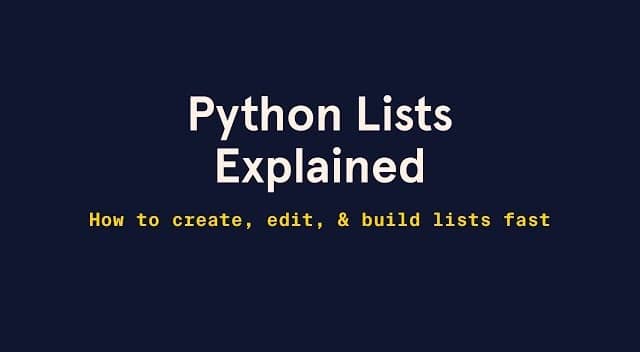In this article, we'll take a look at
Show
Python Lists are one of the most versatile and commonly used data structures. A list is a collection that is ordered and changeable. Lists allow duplicate members and can contain elements of different data types.
Creating a Python List
|
1 2 3 4 5 6 7 8 9 10 |
# Creating an empty list my_list = [] # Creating a list with values fruits = ["apple", "banana", "cherry"] # List with mixed data types mixed = [1, "hello", 3.14, True] |
Accessing List Items
Use indexing to access list items. Python uses zero-based indexing.
|
1 2 3 4 5 |
fruits = ["apple", "banana", "cherry"] print(fruits[0]) # Output: apple print(fruits[-1]) # Output: cherry (last item) |
List Slicing
|
1 2 3 4 5 6 |
fruits = ["apple", "banana", "cherry", "orange", "mango"] print(fruits[1:4]) # Output: ['banana', 'cherry', 'orange'] print(fruits[:3]) # Output: ['apple', 'banana', 'cherry'] print(fruits[::2]) # Output: ['apple', 'cherry', 'mango'] |
Modifying Lists
Lists are mutable, meaning their contents can be changed.
|
1 2 3 4 5 |
fruits = ["apple", "banana", "cherry"] fruits[1] = "blueberry" print(fruits) # ['apple', 'blueberry', 'cherry'] |
Common List Methods
append(item)– Adds an item to the end.insert(index, item)– Inserts an item at the specified position.remove(item)– Removes the first occurrence of the item.pop(index)– Removes the item at the given index (last if not specified).sort()– Sorts the list in ascending order.reverse()– Reverses the list.clear()– Empties the list.
|
1 2 3 4 5 6 |
numbers = [3, 1, 4, 1, 5, 9] numbers.append(2) numbers.sort() print(numbers) # Output: [1, 1, 2, 3, 4, 5, 9] |
List Comprehension
Python supports concise list creation using list comprehension.
|
1 2 3 4 |
squares = [x ** 2 for x in range(6)] print(squares) # [0, 1, 4, 9, 16, 25] |
Nesting and Multidimensional Lists
|
1 2 3 4 5 6 7 8 9 |
matrix = [ [1, 2, 3], [4, 5, 6], [7, 8, 9] ] print(matrix[1][2]) # Output: 6 |
Copying Python Lists
Be careful when copying lists. Use copy() or slicing to avoid reference issues.
|
1 2 3 4 5 6 7 8 9 10 |
a = [1, 2, 3] b = a # Both point to the same list c = a.copy() # New copy d = a[:] # Another way to copy a.append(4) print(b) # [1, 2, 3, 4] print(c) # [1, 2, 3] |
List vs Other Collections
| Feature | List | Tuple | Set |
|---|---|---|---|
| Mutable | Yes | No | Yes |
| Ordered | Yes | Yes | No |
| Duplicates | Allowed | Allowed | Not allowed |
Use Cases
- Storing ordered collections of items
- Dynamic arrays in applications
- Data transformation pipelines
- Iteration and filtering in loops
Conclusion
Lists are a foundational data structure in Python. Their flexibility and ease of use make them essential for beginners and professionals. Mastering list operations will significantly enhance your programming productivity and problem-solving capabilities.






Leave a Comment